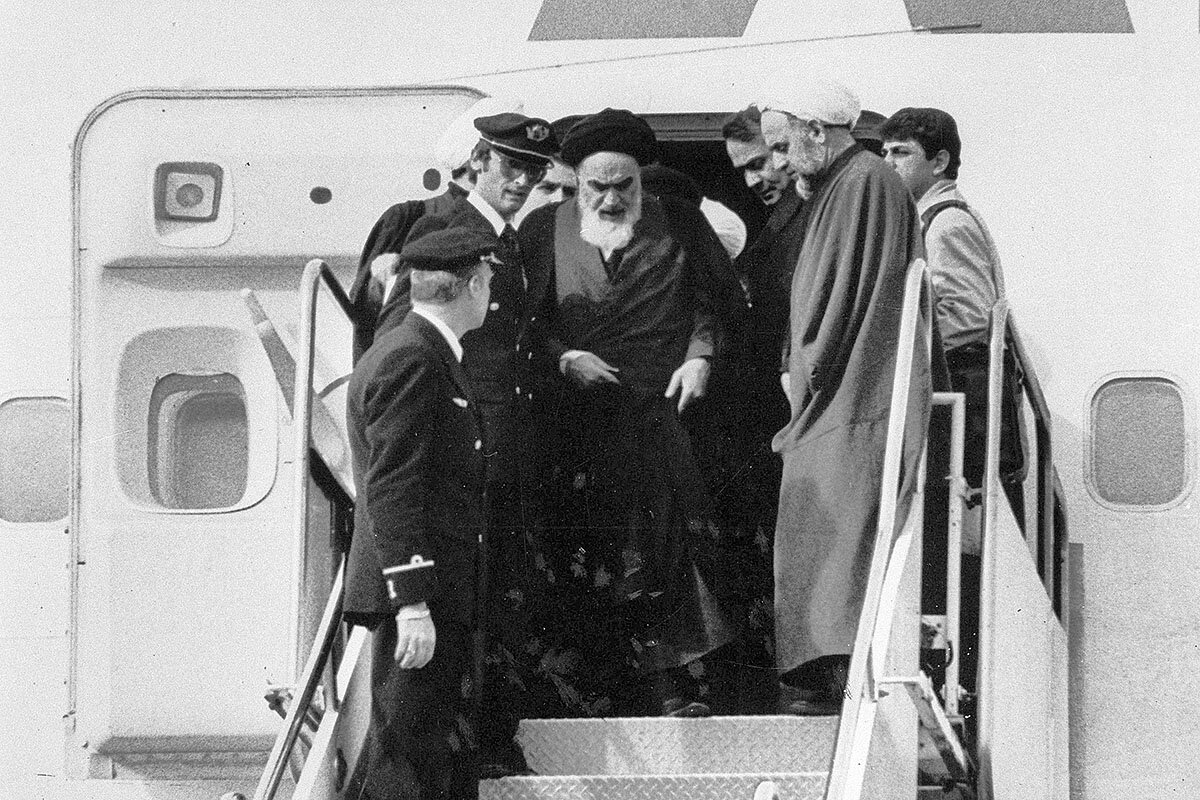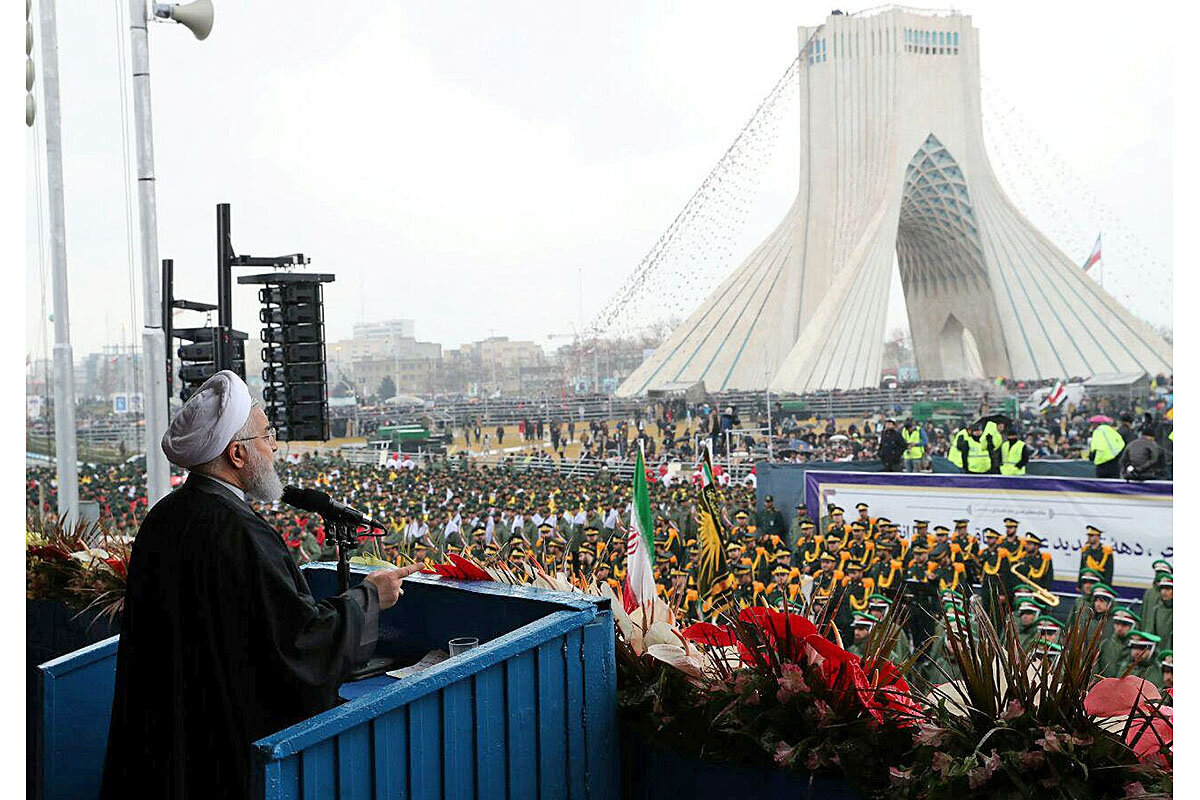As Iran’s revolution turns 40, a consensus: Things must change
Loading...
| LONDON
Recirculating more and more these days, as Iranians assess both the sweet and bitter fruit of 40 years of Islamic Revolution, is a video taken on the plane carrying Ayatollah Ruhollah Khomeini in 1979.
He is about to end years of exile and touch down in Tehran.
Known by his followers as bot shekan, the “idol smasher,” Mr. Khomeini was about to sweep away 2,500 years of monarchy in Iran – and a shah who was a staunch American, Israeli, and Western ally.
Why We Wrote This
Can the Islamic Revolution reform itself? What was once unlikely now seems inevitable as the regime weighs its failures and successes and pushes to reinvigorate flagging support among Iranians.
Khomeini aimed to install instead an Islamic Republic that promised justice, prosperity, and a popular “government of God” that would virulently oppose the United States and Israel.
Today it is clear that Utopia never arrived: The Islamic Republic reels from an ever-growing gap between rich and poor and wide social divisions. It is afflicted by corruption, an economy crippled by US sanctions, and vicious political infighting that has left many Iranians bereft of hope about their future – and believing that the revolution has failed to fulfill its promises.
But on that day four decades ago, as Khomeini was airborne, millions of Iranians awaited their savior, at the airport and in turmoil across the capital. Street fights would escalate between revolutionaries and shah loyalists until a “glorious victory” was declared on Feb. 11, 1979.
In the video the ayatollah, on the plane in a window seat and wearing a stern look and black turban, is asked what his feelings are.
“Nothing,” said Khomeini, whose revolution still rocks global politics after four decades. And then he repeated, “Nothing.”
Today hundreds of thousands of Iranians braved snow and freezing rain to march across the country to mark the 40th anniversary of a revolution that raised expectations but has had bittersweet results. For many Iranians, the official triumphalism masks a moment of deep uncertainty, of disillusion and hopelessness that pervades their lives.
“After 40 years, the Islamic Republic has no similarity to its past,” says a political analyst and Tehran resident who asked not to be named. “It is a corrupted government…. It has some cover of religion, but is not religious. No justice. [There is] nothing [achieved] about the goals that the revolution had: justice, equality, participation of all the people. Nothing.”
One result is a reckoning that looked as unlikely in 1979 as it looks inevitable today about what steps Iran’s leaders can take to reform and reinvigorate the revolution. Iran’s supreme leader, Ayatollah Ali Khamenei, for example, last week set a four-month deadline to restructure the budget system. Yet corruption has never been systematically taken on, and Iran’s parallel intelligence arms often work at odds with each other, trying to unmask “infiltrators” and spies.
A turning point
But much more is at stake as Iranians watch their currency shrivel in value and ask whether the return on a generation-long investment in revolution – including perennial anti-Americanism – has been worth the high cost.
“It’s a turning point in the Islamic Republic, because it’s the first time that the majority of people don’t like them,” says the analyst, citing economic protests that last year hit small towns and villages, where regime support has long been a given. “The Islamic Republic was not a likable government all the time, but it was tolerable and something we could bargain with. It brought stability, and we voted for them. All participation gave them a guarantee to stay and have stability, and they could say, ‘We have the people’s support.’ ”
“But now they don’t have it, and they do understand that,” says the analyst. “It’s quite a danger for the Islamic Republic, such a gap [with] people, between state and society.”
Still, the annual celebration has barely changed and today, as in the past, attracted Iranians from across the social spectrum, including a number of Westernized youth among the legions of more conservative and religious devotees. Anti-US and anti-Israel posters were held aloft, and flags were torched. Martyrs of the Iran-Iraq War of the 1980s were venerated, and devotees with loudspeakers led chants of “Death to America!”
At the 29th anniversary, a Monitor reporter watched an anti-American effigy contest, in which grim depictions of Uncle Sam vied to win a gold coin prize. And at the 35th birthday party, children took part in building waist-high toy Styrofoam centrifuges, used to enrich uranium, in a competition dubbed “Nuclear scientists of the next generation.”
Yet now the Khomeini “nothing” video is being recirculated by regime opponents to suggest that Iran’s most famous personality of the last century – and the revolution he fomented – cared little for the welfare of Iran’s people.
“If we had any wisdom, we should have understood from that very ‘nothing’ answer what was lying ahead for us,” one critic tweeted. “Alas, we were deaf and blind.”
Indeed, the Revolution raised unrealistic expectations. Khomeini himself, speaking shortly after his plane touched down on Feb. 1, 1979, told Iranians that “in addition to providing you a rich, satisfying life” – complete with a new home, free utilities, and free bus rides, he said – “we will exalt your souls.”
But such spiritual purity appears to be a rare commodity nowadays. Instead, this year most senior officials – aware that the periodic economic protests in 2018 were more widespread than ever and often targeted the leadership – tempered their enthusiasm.
Amid reports of shortages, price rises, and rationing of red meat, for instance, President Hassan Rouhani in recent days said Iran is “facing the biggest pressure and economic sanctions in the past 40 years.” He asked Iranians not to blame his “dutiful” government.
The cost of corruption
But many blame chronic incompetence and mismanagement, and have done so on this day for years.
“Happy? Are you kidding me? Of course not,” says Amir, a 30-something driver for Tehran’s “Snap” online taxi service. Five years ago he had his own small business renting luxury cars for ceremonies and weddings.
“The worst thing about this revolution has been the lack of the rule of law. Officials circumvent their own laws, and this has gone down to all levels of the public,” he says.
His business “turned upside down,” and he now struggles to make ends meet. “You don’t have any economic security because of the corruption. I have no future,” he adds.
That problem echoes widely, and not just on the streets.
“Our politicians are problem-creators rather than problem-solvers,” said conservative analyst Amir Mohebian in a late-January interview with the Iranian newspaper Arman. “The government should keep in mind that protests from the lower class have every potential to turn radical.”
Despite such views, Mr. Khamenei sought to reinforce the pillars of the revolution in a speech Friday, saying the nation’s “massive presence” on the streets “scares and breaks the enemy [as] an embodiment of national resolve and unity.”
“Death to the USA!” chants did not mean an end to the American nation, he clarified, but death to its rulers. He named President Trump and others.
Yet, according to reformist analyst Sadegh Zibakalam, that anti-imperialism campaign has “served as a poison and inflicted the biggest harm upon the Islamic Republic,” since the original discourse of the revolution “was about freedom and democracy.”
“If you force our radical and hard-line revolutionary people into not using the name ‘America’ in their speeches, they will have nothing to say,” Mr. Zibakalam said in a public debate last December. “They have been hiding behind this for 40 years, refusing to address the fundamental issues.”
‘At least we have security’
Still, for some Iranians, the revolutionary glass remains half full.
“I’m happy because at least we have security,” says Haj Esmaeel Malayeri, a rich, religious, and bearded businessman in his late 60s in west Tehran.
“It’s not Utopia, I know. But take a look around. All our neighbors are in misery and instability,” he says. “Let’s be fair. This revolution has been facing pressure from almost all world powers, but it has managed to survive, and that’s enough to make us feel happy.”
But perceptions of inequality are exacting a high price.
“There is a sense of failure in many things, especially this huge gap between rich and poor,” says a veteran observer in Tehran who asked not to be named. Indeed, social media posts showed some marchers today carrying signs with the slogans “No to embezzlement,” and “No to aghazadehs,” the derogatory term for the well-connected, rich, and ostentatious offspring of the elite.
For most Iranians, life has improved “very much” since 1979 in terms of education, health, roads, and communication, the observer says, but adds that a majority of ordinary Iranians sympathized with the 2018 protests, even if they did not participate.
“Maybe this is a lesson to learn that riots aren’t the way out,” he says. “But what is the way out? Nobody has the answer. So that adds to the feeling of frustration that nothing is getting better.”
One solution may lie in accountability for corruption, suggests the reformist newspaper Ghanoon. An article last week called for an end to luxurious displays in front of fellow Iranians “who have no bread to eat.”
“Isn’t it better … to bring to justice all those institutions which are tasked with auditing and supervision and ask them why they were fast asleep this whole time?” asked the newspaper. “The monarchical lifestyle keeps parading itself before the eyes of our common people in the form of fancy cars with arrogant drivers who break the hearts of the needy.”
But politics still trumps the economy in revolutionary Iran.
“There are certain people in our country who insist on extremism,” the reformist lawmaker Mahmoud Sadeghi railed last week. “We have to be worried about what the hard-liners have in store for the future of our country.”








